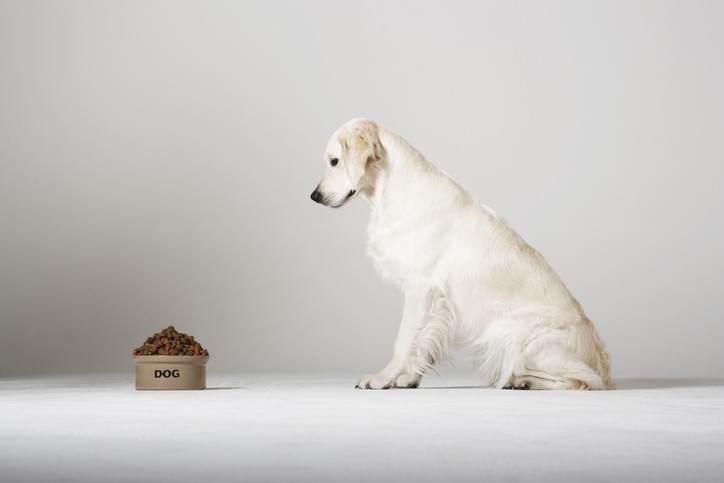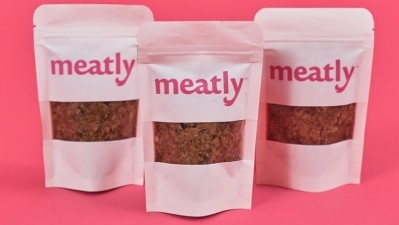The race to incorporate cultivated meat in pet food

And a US feeding trial is imminent.
CULT Food Science's subsidiary, Further Foods, recently announced plans to conduct the first-ever FDA trial of cultivated meat in a pet food product. It aims to position its product, Noochies!, as a pioneer in this respect in the US market.
A publicly traded company, CULT Food Science is on a mission to invest in and commercialize cellular agriculture products. We spoke to its CEO, Mitchell Scott, to get a deeper dive on the FDA feeding trial.
“The US has begun implementing a framework for cultivated meat in human food, but this is the first time it's being applied to pet food; the trial, for the most part, will evaluate the use of cultivated chicken ingredient in treats. But I'm hopeful [the findings] will accelerate other pet food applications involving cultivated meat,” he told us.
Further Foods, continued Scott, has submitted the feeding trial design protocol to the US Food and Drug Administration (FDA), and is now waiting for the agency to respond.
The company has been collaborating with Dr Sarah Dodd, a leading veterinary nutritionist, on the design of the study to ensure it meets all FDA requirements; if the design is approved, Further Foods plans to get the trial underway in the fourth quarter of this year.
Asked how the company determined the inclusion doses for the study, Scott said:
“We collaborated with Dr Dodd and incorporated feedback from the FDA. Since we're initially launching with treats, which are consumed less frequently, we decided on a lower inclusion rate. However, the trial itself is comprehensive, with a significant amount of the product being fed to the dogs.”
So, even though the initial product will be a treat, the trial is designed to assess the ingredient's effectiveness more broadly, potentially supporting other uses in the future.
“The feeding trial is more in depth than just a treat trial. It will support the treat launch now and pave the way for using the ingredient in other formats, such as full pet foods, later.”
He is confident that the trial results will be positive and sufficient to meet the FDA's requirements. "The main uncertainty right now is whether we can secure a sufficient supply of this ingredient to effectively commercialize and launch the product in a meaningful way.”

Regulatory battleground: Who got there first?
Looking to the global regulatory landscape, and, in the UK last month, Meatly reported that it had received regulatory clearance to sell cultivated chicken meat in the domestic pet food market.
This approval came after 18 months of collaboration with the UK's Food Standards Agency (FSA), the Department for Environment, Food and Rural Affairs (Defra), and the Animal and Plant Health Agency (APHA).
Along with the UK regulatory green light, Meatly has compiled a comprehensive safety dossier and has conducted extensive testing to demonstrate that its cultivated chicken is safe and healthy for pets.
The testing, it reported, showed that the cultured meat is free from bacteria and viruses, the nutrients used to grow the cells are safe, and the final chicken product is nutritious and free from GMOs, antibiotics, harmful pathogens, heavy metals, and other impurities.
CEO of the startup, Owen Ensor, said that in passing this regulatory review, Meatly was the first company in the world to get authorization for cultivated pet food.
However, Czech startup Bene Meat Technologies (BMT) disagreed. Following Meatly's announcement, BMT released a statement claiming to be the first to gain EU market access for cultured pet food ingredients and the first in the cultivated pet food field globally.
“Our product, a pet food ingredient, has been registered under the EU Feed Materials Register as "Cultivated cells of mammalian origin" with the ID number 009569 since November 2023."
Regulatory experts we spoke to confimed that registration on the EU Feed Materials Register is the exclusive responsibility of the notifier. The listing of a product in this way cannot be legally used as an evidence of the status of the product as a feed or feed material and its lawful placing on the market. BMT says the Czech state authority has guaranteed the safety of the production of its registered ingredient.
“The Central Institute for Supervising and Testing in Agriculture, a competent Czech state authority, approved the production of our product under registration number CZ 802529-01 on October 27, 2023. According to that authority, BMT has fulfilled all of the necessary conditions for approval.
"These registrations authorize our company to produce and commercially sell the product as a pet food ingredient within the EU market.”
BMT is working to increase production, the company added. “We are already supplying our cultivated meat ingredient to several pet food manufacturers to develop a final pet food product.”

We clarified the regulatory aspects further with Tomáš Kubeš, head of strategic projects at BMT.
He told us the startup is also planning or conducting various trials and tests that go beyond regulatory requirements. “These tests are designed to provide additional scientific data from trusted third parties, ensuring the safety of our product for customers.”
Regarding the necessary licenses, he confirmed that the company holds an approval number CZ 11B00318 for handling animal byproducts (ABP) for research purposes only. This license allows the company to import cells and handle animal tissues for research, but it is not related to its current cultivated meat products for pet food. And he emphasized that an ABP license is not required for its "cultivated cells of mammalian origin."
As for the company's plans for industrial-scale production, he revealed, "We are targeting a production capacity of approximately 500kg of cultivated meat per day. Our facility is scheduled to open in late 2024 or early 2025, initially operating below full capacity. We expect to reach full capacity gradually throughout 2025."
He mentioned that the partner for the first product launch will be announced in early autumn.
On the timeline for including cultivated meat in pet food formulations in the EU, Kubeš explained, "Our upscale team is coordinating with equipment suppliers to complete our production facility. Following the product launch, we will scale up production. Additionally, we plan to introduce cultivated meat for human consumption in 2025."
Industrial volumes
Meatly has been collaborating with pet food manufacturers and plans to launch the first samples of its commercially available pet food this year. Beyond these initial samples, its primary focus will be on cost reduction, aiming to scale production to industrial volumes within the next three years.

Ensor told us: “It’s likely that Meatly will send small-scale products to its manufacturing partners before the end of the year. However, with a focus on scaling in 2025, truly industrial production volumes are expected around 2026-27.”
Further feeding trials with dogs are planned for August as the company works to increase output while keeping expenses under control.
“One advantage is that mainstream pet foods combine meat with other ingredients, allowing us to further reduce costs by mixing our cultivated meat with other healthy plant-based ingredients if needed,” Ensor noted.
In May, Meatly announced the development of a protein-free culture medium, a first in the cultivated meat industry, setting a new benchmark by creating this medium for just £1 per liter, compared to the typical hundreds of pounds per liter. A culture medium, the mix of nutrients used to grow animal cells, is essential to the production process and accounts for most of the costs involved. Reducing these costs has been a major hurdle as the industry aims to scale up and achieve price parity with traditional meat products.
From cell culture to biomass fermentation
Numerous other startups are working on developing meat proteins for pet food inclusion. While some use cell culture, others employ traditional or biomass fermentation to create nutritionally valuable alternative proteins.
“We’re big fans of all the companies emerging in this space,” Rich Kelleman, Bond Pet Foods' founder and CEO, said in February.
He was speaking following his company delivery of two metric tons of animal protein to Hill's Pet Nutrition, which Bond said marked a significant step toward commercializing its fermentation technology for pet food. Hill's said the volumes supplied would allow it to formulate and assess a range of products at its Pet Nutrition Center in Topeka, Kansas, for regulatory review and evaluation. The data from these tests will be used for the ingredient's review by the FDA's Center for Veterinary Medicine (CVM) and to develop market prototypes.
Last year we heard how BioCraft Pet Nutrition, a company developing cultured meat for the pet food market, had created a chicken cell line for both cat and dog food. It is derived from stem cells; the cultured chicken ingredient develops under process conditions inside a bioreactor.
Bond’s approach is different. It sources DNA extracted from a blood sample from a live chicken, and then, using a fermentation process, the company’s R&D experts combine that DNA with yeast and put into a fermentation tank, where it is fed sugars, vitamins, and minerals. Once it reaches a certain density and composition, the fermented meat protein is dried and ground into a powder.
“We’re using a technology - precision fermentation – that has been around for more than half a century to make enzymes for cheese manufacturing to vitamin B12 and lactic acid. We’re just reassembling the process to produce animal proteins more efficiently and responsibly like chicken, turkey and fish that can be foundational for pet health.”
Bond Pet Foods is developing a range of animal proteins that are nutritionally complete and scalable, with a cost structure suitable for inclusion in various pet food formats, including kibble and wet food; Kelleman is confident that the company's straightforward production process will allow its ingredients to be competitively priced compared to traditional animal proteins used in the industry.
Price parity
Shannon Falconer, CEO, BioCraft, told us the startup met with the FDA's CVM in spring 2023.
"During this meeting, the FDA provided clear guidance on the path to market and their expectations for a feeding trial involving cultivated meat. BioCraft's ingredients have been developed according to these specifications.
“There has been great regulatory progress for the industry with the FDA approving cultivated meat from UPSIDE and Eat Just, Singapore approving products from Eat Just and Vow, and Israel approving Aleph Farm's cultivated meat.
“In response, BioCraft has shifted its focus to addressing the industry's greatest challenge: achieving price parity with traditional meat.”
The core mission of the cultivated meat industry, she continued, is to reduce dependence on industrial animal agriculture, which means moving massive volumes of product.
“This is only feasible if we can offer consumers a competitive price compared to traditional meat. By leveraging our team's scientific expertise and concentrating resources on creating an ingredient that eliminates downstream processing, BioCraft has succeeded in producing cultivated meat at a price point that works for pet food companies. At this stage, it is cost—not regulatory approval—that will make or break this industry.
“We will have announcements regarding our regulatory status in the near future in advance of our first shipments coming to market as an ingredient in leading pet food brands.”
















